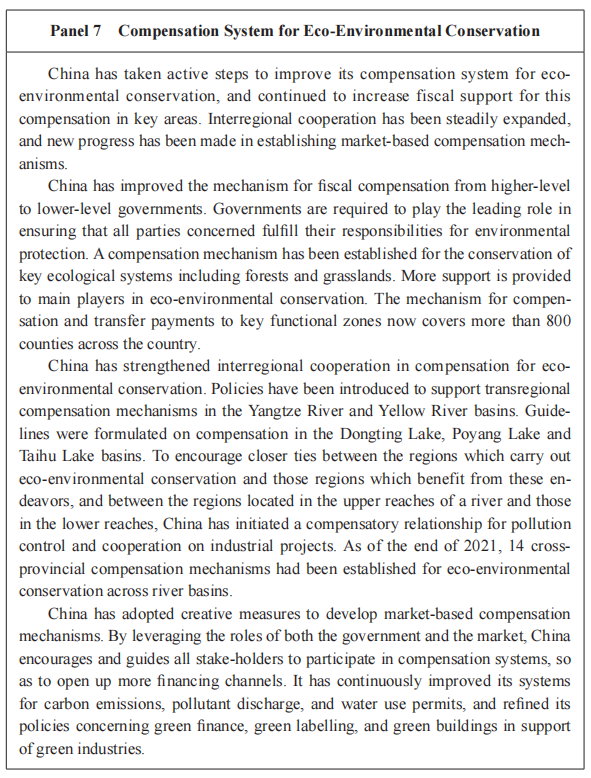Xinhua | January 19, 2023
VI. Improving the Institutions and Mechanisms for Green Development
Sound institutions and mechanisms are essential to green development. With this understanding, China has stepped up efforts to create an eco-environmental conservation system based on clear orientation, sound decision-making, effective implementation, and strong incentives, and continued to improve government performance in promoting green development. This provides a solid guarantee for the realization of the country's green development goals.
1. Strengthening the rule of law
China is committed to the rule of law in pursuing progress in eco-environmental conservation. It has written into its Constitution eco-environmental improvement and conservation, and promulgated and/or revised laws such as the Yangtze River Protection Law, the Yellow River Protection Law, the Land Administration Law, the Forest Law, the Grassland Law, the Wetland Protection Law, the Environmental Protection Law, the Law on Environmental Protection Tax, the Law on the Prevention and Control of Atmospheric Pollution, the Law on the Prevention and Control of Water Pollution, the Law on the Prevention and Control of Soil Pollution, and the Nuclear Safety Law. A legal system for eco-environmental conservation that covers all key areas, all types of resources, and all environmental factors has taken shape. China has also made consistent efforts to refine green development standards for key areas — more than 3,000 such standards have been formulated or amended.
To better investigate and strictly punish violations of laws and regulations concerning natural resources and the eco-environment, China has reformed the system that places the monitoring, supervision, and law enforcement activities of environmental protection bodies below the provincial level under the leadership of the same type of bodies at the immediate higher level. To strengthen coordination between the criminal justice system and law enforcement by government departments, China has established a system for procuratorates, courts, public security organs, and government departments responsible for coordinated law enforcement for environmental protection, enabling them to share relevant information, issue case briefings, and transfer cases among them. This has built a strong synergy for the investigation and punishment of environmental crimes, and provided powerful legal safeguards for green development.
2. Tightening supervision and management
China has improved the performance evaluation system for green development, and taken strict measures to ensure that enterprises fulfill their principal responsibilities and that the government performs the duty of supervision in pursuing green development. GDP growth is no longer the sole criterion for the assessment of the development of regions or the performance of officials. Instead, binding targets concerning resources and the environment are set for economic and social development, and a more balanced assessment system for economic and social development is in progress — one that measures the use of resources, energy consumption, environmental damage, and the eco-environmental impact. This allows assessment to play its full guiding role in promoting green development.
China has put in place an accountability system for leading officials, and formulated and/or revised a number of CPC regulations, including the Measures for Holding Leading Officials of the Party and the Government Accountable for Environmental Damage (for Trial Implementation), the Regulations on Central Environmental Inspections, and the Regulations on the Auditing of Natural Resource Assets for Leading Officials at the End of Their Tenures (for Trial Implementation). These are designed to ensure that Party committees and governments assume equal responsibilities for environmental protection, that leading officials perform their environmental protection responsibilities with diligence, in addition to their other prescribed duties, and that they are held accountable when they fail to do so. China mandates end-of-tenure auditing of natural resource assets for leading officials, and imposes lifelong accountability for environmental damage. By implementing the central environmental inspection system, China has ensured that all parties concerned truly fulfill their responsibilities for environmental protection, and has solved many environmental issues of pressing public concern.
3. Improving market-based mechanisms
China is creating institutions and mechanisms for green development through which the government provides strong guidance, enterprises are fully engaged, and the market plays an effective role, thereby generating society-wide enthusiasm and participation. It has introduced new measures to improve the pricing mechanisms in key areas such as water and energy saving, sewage and waste treatment, and air pollution control, adopted more than 50 preferential policies to cut taxes and fees, encouraged better resource allocation, and supported conservation and efficient use of resources to advance green development. China has enforced a unified registration system for ownership of natural resources and an eco-environmental conservation compensation system that covers forests, grasslands, wetlands, deserts, water bodies and farmland. It is working on mechanisms for realizing the market value of ecosystem goods and services. China also encourages and supports private investment in environmental conservation and rehabilitation.
On the base of a reasonable ceiling for total consumption, China has established initial allocation and trading systems for water, energy, pollution, and carbon permits. With the opening of the national carbon emissions trading market and trials in green electricity trading, progress is being made in allowing the market to play a fundamental role in the allocation of eco-environmental resources.
In order to boost green finance, China has developed a multi-level market and a portfolio of green financial products, such as green credit, green bonds, green insurance, green fUnds, and green trust. At the end of 2021 China's green loan balance in RMB and foreign currencies stood at RMB15.9 trillion, and its outstanding green bonds at RMB1.1 trillion, both ranking among the largest in the world.


